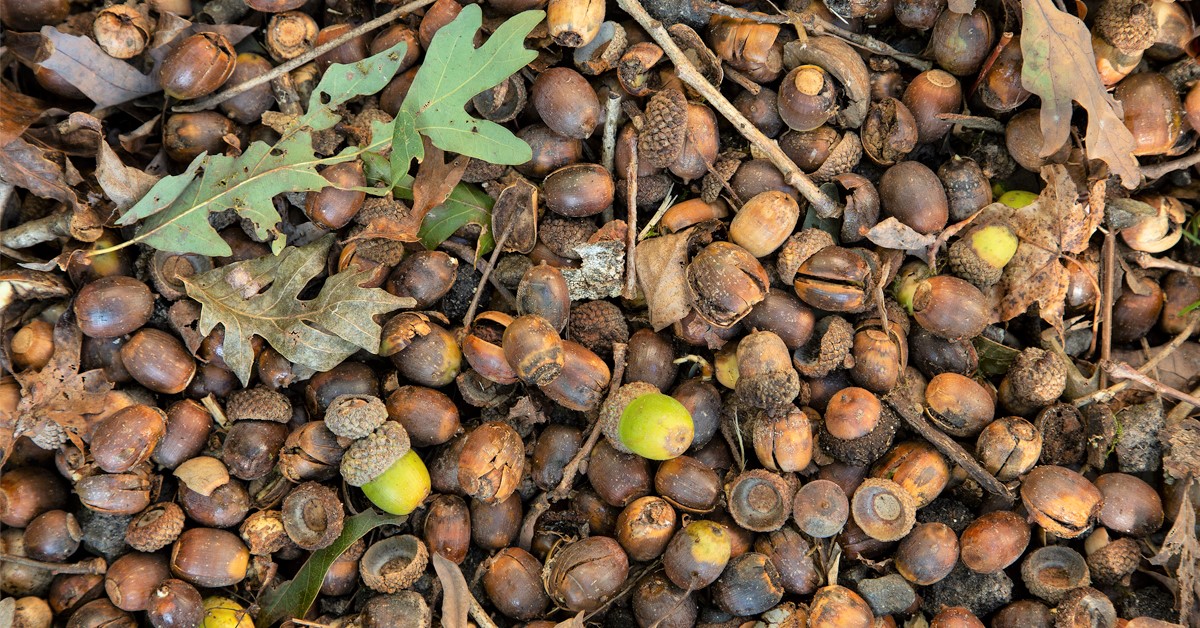
Because acorns impact both wildlife and hunter success, the Department of Wildlife Resources (DWR) annually monitors acorn crops across the state.
More than 200,000 hunters are taking to the woods this fall in search of deer, turkeys, bears and a host of smaller game species. Hunters should know that acorns are a nutritious food providing protein, fat and energy in the diets of 90 species of game and non-game animals in Virginia.
There seem to be few things normal about 2020, but one of them is the state’s acorn production. DWR’s surveys have revealed that both white- and red-oak acorn crops are close to the long-term median in 2020. Thirty-one survey sites were sampled across the commonwealth by DWR staff and numerous partner organizations and volunteers.
Sites throughout the mountains were extremely low for white oak, especially on high elevation north- or east-facing slopes. Better production was seen on southern slopes, particularly at low to medium elevations. The North Mountain region in particular has seen a significant decline in white oak production in the past three years. Throughout the Piedmont, white oak crops were boom or bust. Some sites were well above the long-term median while others were poor. The Tidewater region had above average white oak production on two out of three survey sites.
Red oak production was consistently above average in the mountains but fell shy of the department’s long-term median in the Southern Piedmont and Tidewater regions. In the mountain regions, red oak production ranged from good in the southern and central mountains to fair in the northern mountain counties.
In the Piedmont, red oak acorn production was fair throughout the region with the exception of poor production in the southern Piedmont. In the Tidewater, two out of the three routes were failures, but one route came in well above the survey average.
Mast abundance ratings are intended to reflect regional averages; however, mast crops are not uniform across a region. Acorn abundance can vary among local areas that are only 10-15 miles apart. Anecdotally, the acorn crop (particularly for white oak) appeared to be above average throughout certain areas of the state. Scouting will once again prove useful to Virginians going outdoors this fall with or without a weapon to enjoy our wildlife and perhaps harvest a deer, bear or wild turkey.
Acorns are a staple food for Virginia’s wildlife, providing important resources to meet the physical challenges of winter weather and reproduction in the following spring. Wildlife needs to move less when acorns are abundant, making game harder to find and leaving some hunters to wonder if game populations are lower. Under these conditions, hunter success rates decline. Conversely, when acorn crops fail, game animals search forests and fields more often for other food sources, which makes game easier for hunters to find and may increase a hunter’s odds of success.
The Department of Wildlife Resources (DWR) is beginning its biennial process for changing the regulations guiding hunting, trapping, wildlife and public lands recreational opportunities. DWR takes public opinion into account when developing regulations, and is looking for input. This process offers the opportunity for citizens to suggest potential regulatory changes directly to DWR during the public scoping period, which will run through Dec. 11, 2020.
All items submitted will be reviewed by DWR staff. A summary of the comments received during the public scoping period will be presented to DWR’s Wildlife and receive and consider regulation amendments recommended by DWR staff and the public. For those regulation amendment recommendations proposed by the board, a formal public comment period will be conducted from late March through early May 2021. The board will take final action on its regulation amendment proposals at its May 2021 meeting.
The public is welcome to participate in all phases of the regulation amendment process.
To participate in the public scoping period, submit your input by email: regcomments@dwr.virginia.gov .
The Department of Wildlife Resources is also excited to announce the start of the 2021 trout stocking season. Through May 31, DWR hatchery staff will stock nearly one million catchable-size fish into 200 waters throughout Virginia.
Favorable conditions at the hatcheries this summer mean that anglers can expect quality fish to be stocked all season long. The department is asking anglers to respect social distancing guidelines when interacting with hatchery staff during stockings. Please maintain a minimum distance of 6 feet and use facial coverings when speaking with staff.
–Katie Martin, DWR Deer/Bear/Turkey Biologist




